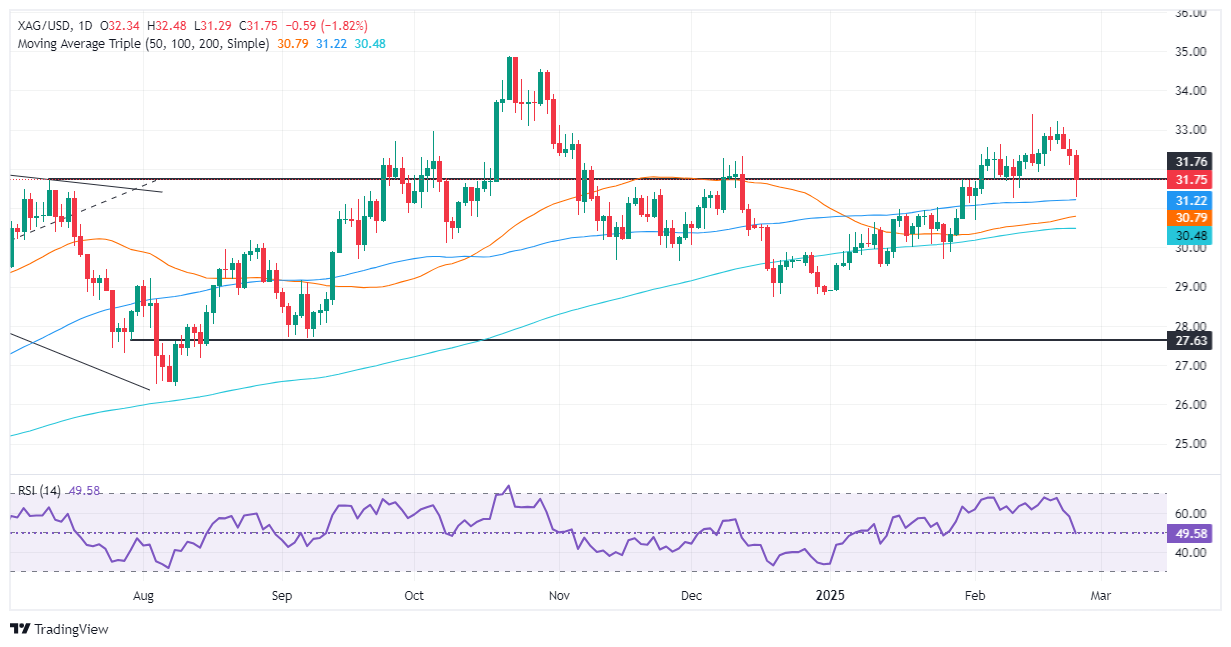Silver hit a two-week low of $31.29 before rebounding above $31.50.
The Relative Strength Index (RSI) is sending bearish momentum signals, with key support at the 100-day Simple Moving Average (SMA) at $31.20.
If XAG/USD recaptures $32.00, potential upside targets are $32.48 and $33.00.
On Tuesday, silver prices plunged over 1.80%, sliding below $32.00 after hitting an intraday high of $32.48 on risk aversion and traders taking profits amid uncertainty over U.S. trade policy. XAG/USD traded flat at $31.73 at the start of Wednesday’s Asian session.
Despite hitting a two-week low at $31.29, XAG/USD rebounded near the 100-day simple moving average (SMA) at $31.20, a break below which would open the way for the bears to push the silver price towards the $30 mark. However, the bulls emerged and pushed the precious metal above $31.50, keeping their hopes alive for a retest of $32.00.
The momentum turned bearish with the relative strength index (RSI) below 50, suggesting that sellers are dominating the market. Hence, the possibility of further downside is high.
On the other hand, if the silver price climbs above $32.00, the bulls can push the price towards the February 25 high of $32.48. If this level is breached, they will continue to dominate the market, ready to challenge $33.00.

Silver is a precious metal that is heavily traded between investors. It has been used throughout history as a store of value and a medium of exchange. Although not as popular as gold, traders may turn to silver to diversify their portfolios, because of its intrinsic value, or as a potential hedge during periods of high inflation. Investors can buy physical silver in the form of coins or bars, or trade it through instruments such as exchange-traded funds (ETFs). ETFs track the price of silver in international markets.
Silver prices can be affected by a variety of factors. Geopolitical instability or fears of a deep recession could see silver prices rise due to its safe-haven status, though not as much as gold. As a non-yielding asset, silver tends to rise with lower interest rates. Its movements also depend on the performance of the U.S. dollar (USD), as assets are priced in dollars (XAG/USD). A stronger dollar tends to suppress silver price gains, while a weaker dollar can push it higher. Other factors, such as investment demand, mining supply (silver is much more abundant than gold), and recycling rates can also affect prices.
Silver is widely used in industry, especially in areas such as electronics or solar energy, as it has one of the highest electrical conductivity of all metals, higher than copper and gold. A surge in demand can increase prices, while a drop in demand tends to reduce them. Dynamics in the U.S., Chinese, and Indian economies can also contribute to price volatility: for the U.S. and especially China, their large industrial sectors use silver in a variety of processes; in India, consumer demand for gold jewelry also plays a key role in determining gold prices.
Silver prices tend to follow the movements of gold. When gold prices rise, silver generally follows suit, as their status as safe haven assets is similar. The gold/silver ratio shows the number of ounces of silver required to equal the value of one ounce of gold and may help determine the relative valuation between the two metals. Some investors may view a high ratio as an indicator that silver is undervalued or gold is overvalued. Conversely, a low ratio may indicate that gold is undervalued relative to silver.